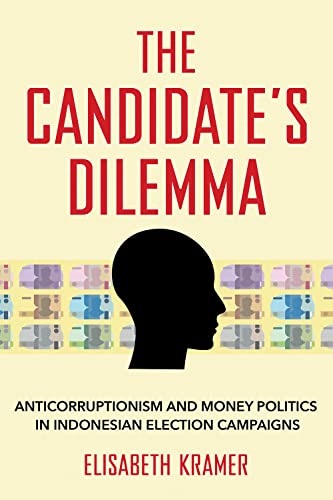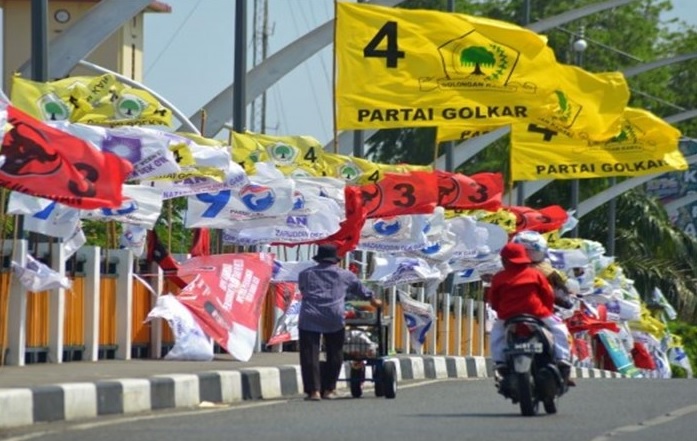Burhanuddin Muhtadi
How would a candidate who proclaims to be clean, and committed to an anti-corruption campaign message, garner votes in an environment where money politics is so rampant? Is the anti-corruption message sufficiently effective to generate electoral support when transactional politics are widely assumed to be the most prevalent, if not the only, game in town? Elisabeth Kramer attempts to answer these questions through an intensive ethnographic study of three self-proclaimed anti-corruption candidates in Indonesia. She lays out the dilemmas faced by the three candidates amid growing pressure to use vote buying strategies to win their electoral battles.
As highlighted by the examples of Kramer’s three case studies, the dilemma between pragmatism and idealism leads to varied electoral outcomes for each candidate. After explaining the structural context and changes in the increasingly competitive electoral system in Chapter 1, and the issue of corruption and counter-corruption efforts in Chapter 2, Kramer dives into her case studies. In Chapter 3, she thoroughly explores the figure of Ambo, a legislative candidate strongly committed to an anti-corruption message who refused to employ money politics as a strategy in his campaign, despite the strong pressure he faced from his constituencies and supporters. In Chapter 4, she presents the figure of Ayu, who initially adopted a strong idealistic position committed to anti-corruption issues in her electoral campaign but eventually caved in to vote-buying strategies due to the increasingly pragmatic demands of voters. Finally, Kramer describes the paradoxical character of Bontor, whose long track record of championing anti-corruption issues in the national media was counterbalanced by an electoral strategy that maintained his voter base through a massive clientelist approach, i.e. exchanging goods and services for political support.

One premise in this book, which also forms the basis for Kramer’s case studies, is that since corruption is a major perennial issue in Indonesia it must be immediately tackled. Championing an anti-corruption message during the electoral campaign season is assumed to be effective in generating large electoral payoffs. Kramer uses the examples of the Democrat Party (PD) and the Prosperous Justice Party (PKS) to demonstrate this. These two parties rose to power on the back of anti-corruption platforms, but both later imploded and lost the public’s trust when their party elites were implicated in high-profile corruption scandals. Kramer also draws on public opinion surveys which highlight corruption as being an ongoing source of discontent in Indonesia. For this reason, Kramer argues, selling yourself as an anti-corruption candidate and rejecting transactional politics will, at the very least, grab the imagination of voters.
At this point, Kramer fails to capture, or at least does not further elaborate on, the disconnect between a campaign narrative at the macro- or national level and micro-level electioneering. While she quite rightly identifies the paradox between the prevalence of transactional electoral strategies and anti-corruption rhetoric, Kramer did not dig further into why there was a gap between the macro-level campaign narrative and the micro-level strategy. At the macro-level, mobilising anti-corruption issues may be useful in buttressing the party image. But at the micro-level the message of anti-corruption is oftentimes a luxury the legislative candidates can not afford to indulge in let alone sell to the voters. The open-list proportional system, first adopted by the Indonesian electoral system in 2009, means candidates must compete against their rival candidate within the same party for votes. Under this system they only need to secure a small marginal number of votes in order to defeat their internal rivals, with many engaging in money politics to get ahead. In the 2014 election when the author conducted her research, politicians had had time to prepare for the open-list proportional system. In the 2009 election, this system was implemented just a few months before the election and so many candidates had not yet adapted to using money politics. It was no surprise, therefore, that there was an increase in the incidence of vote buying from 10 per cent in 2009 to 33 per cent in 2014.
It should be noted that although money politics in Indonesia is comparatively prevalent, two-thirds of the population report that they are not exposed to vote buying offers. This group of voters may indeed consider a party's clean image as a reason for voting for them. At the micro-level, however, voters will find it difficult to assess if the individual candidate's track record is truly clean from corruption or not. Candidates are also fighting it out for the 33 percent of voters who are already connected to parties, or those who are connected through personal networks and are willing to give their votes as long as it comes with material rewards.
As Kramer points out, although the electoral impact of vote buying is small, in Indonesia’s ‘first past the post’ electoral system, in a very tight contest such a strategy can make a real difference toward election outcomes. If candidates do not engage in vote buying they feel disadvantaged because their rivals use clientelistic techniques. In the end, all candidates are tempted to do the same even though they are aware that the strategy will fail to garner a large number of votes. It is all about the margins.

Such conditions explain why there is a disconnect between the anti-corruption narratives adopted by the three candidates under study in this book and the campaign strategies they used in practice. Even a candidate like Ambo, who the author claims had a stronger anti-corruption image compared to Ayu and Bontor, is forced to engage in indirect money politics by donating to local mosques. Although he refused to undertake mass vote buying, neither did he feel he could criticise the practice of money politics in his electoral district for fear of it becoming counterproductive. The paradox between the narrative at the macro-level and the strategy at the micro-level was fully realised in the case of Bontor, who heroically rejected corruption before the national media, even calling for the death penalty for corruptors, but in his electoral district became involved in acute vote-buying practices.
Apart from being institutionalised, the paradox between anti-corruption rhetoric at the macro-level and electoral strategy at the micro-level is also the result of the vagueness around what constitutes ‘money politics’ in relation to corruption in the Indonesian context. Many voters and politicians interpret vote buying not as buying and selling votes, but more as gift giving. The money they receive is not seen as an act of bribery but as a cultural token of gratitude. Note that in Indonesian money politics the money is generally doled out in small amounts. Ordinary voters commonly perceive corruption to involve large amounts of money. This lack of clarity about vote buying as a commodity or gift, means voters and candidates feel trapped in a vicious cycle of corrupt practice when they engage in monetary or material exchanges during elections.
The nature of such ‘embedded’ ethnographic research meant Kramer had to negotiate some difficult ethical terrain in relation to her subjects. While she used pseudonyms in order to disguise the identities of the three candidates she studied, the level of detail necessary to cast their narratives ultimately allows an informed reader to guess at their real identities. For the candidates shown to have carried out illegal activities, such as money politics, questions may remain about the potential risks to them if exposed.
Overall, the strength of this book lies in the author’s ability to present complexities and contradictions between anti-corruption rhetoric, the temptation of money politics and electoral campaigning with nuanced detail. Despite facing similar structural constraints and voter pragmatism, the book shows that the three candidates under study were able to produce different responses and outcomes. This book is worth reading for anyone who is interested in Indonesian politics or in the comparative political study of clientelism.
Elisabeth Kramer, The Candidate's Dilemma: Anti-corruptionism and Money Politics in Indonesian Election Campaigns, Cornell University, Southeast Asia Program Publications, 2022.
Burhanuddin Muhtadi (burhanuddin.muhtadi@uinjkt.ac.id) is a senior lecturer at the Faculty of Social and Political Sciences, Syarif Hidayatullah State Islamic University, Jakarta. He is also an executive director of the Indonesian Political Indicator (INDIKATOR) and visiting research fellow at ISEAS – Yusof Ishak Institute, Singapore.
